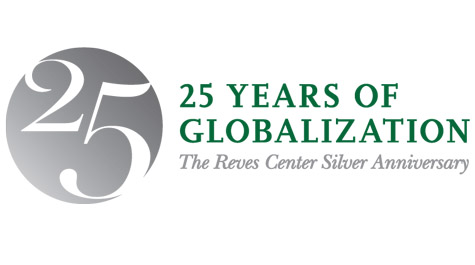A silver anniversary Q&A with Stephen Hanson
Q: Twenty-five years is a prized symbol of stability, no matter what field. The Reves Center is coming to the end of a year-long 25th anniversary celebration. Can you put that into perspective compared to similar programs at other universities?
Hanson: We’re not the oldest international center by any means. A lot were founded after World War II and in the 1960s, when programs for international studies were developed, basically as a tool of U.S. diplomacy in the Cold War and in order to train the next generation of global specialists. In that respect, the Reves Center isn’t that old.
But what’s neat about us is that we were founded in 1989 -- we have been there for the next era of global change. The Berlin Wall fell six months after the Reves Center was founded, so we were already oriented early on toward questions that were a bit different than the old Cold War paradigm. We were a lot more focused on citizen diplomacy, engagement of global populations that were able to be in touch more easily because of new technologies. The Reves Center’s founder, Jim Bill, had a major focus on getting undergraduates’ hands dirty, you know, studying the world. Study abroad programs really took off from that point on, and the Reves Center has been the key promoter of that.
What we’re seeing today with the Islamic State, Russia’s intervention in Ukraine and other international crises is that we might be on the verge of another pivot point, which we’re in a good position to explore, given what we’ve accomplished.
Q: In March 2014, William & Mary joined the Institute of International Education (IIE)’s Generation Study Abroad initiative to double the number of American students who study abroad by the end of the decade. The university has committed to increasing the number of undergraduate students who study abroad to 60 percent over the next five years. Can you elaborate on what else we hope to accomplish?
Hanson: The strategic plan we adopted, and the Board of Visitors approved, includes specific numeric targets. It’s 60 percent of our undergraduates that we hope will experience study abroad before graduation. Right now, we’re just a little bit below 50 percent, so we think that’s attainable by 2018. We are striving to get at least 600 international students from at least 60 countries; that’s the other side, and it’s just as important. We want to bring students here from around the world. We’ve outstripped the first target because we’re already nearly at 700 students this year, but we don’t have the 60 countries. In a way that’s the more significant goal because it means finding places that haven’t heard of us yet and getting students there to come join us. That’s across the university; it doesn’t have to be undergraduate or in Arts and Sciences. It includes the growing populations of international students in the Law School, Business School and School of Education as well. The Virginia Institute of Marine Science (VIMS) has always had a strong international component.
The third target we put into the strategic plan is that by 2018 we are going to establish a signature research project on each continent. We’re already close. We’ve got significant things going on in East Asia; lots going on in Africa with AidData and Young African Leaders Initiative (YALI). Europe is fairly easy for us to claim, and Antarctica is done because VIMS goes there every year. Our Latin American engagement needs a little bit of additional support and we’re thinking of how to do that.
Q: Describe the ‘Hanson Stamp’ on the program.
Hanson: I was building on the legacy of the previous directors, all of them. There has been a kind of consistency in vision all along. I won’t claim anything radically new. I’ve tried to emphasize continuously the way Reves can serve the entire university as the kind of starting point for things international. The engagement of the professional schools and programs, along with the undergraduate core, is extremely important.
We are in a sweet spot in terms of our size to do global work. We’re not so small that we can’t be everywhere and do serious research, but we’re not so huge that it’s impossible to coordinate. One of the things I’ve tried to accomplish in my three years is getting the five academic deans -- also the dean of Swem Library and the rest of the administration -- on board in a coherent way. We’ve made tremendous progress.
I’ve set these targets and they’ve been ambitious targets, but I think we’ve really pushed. We’ve gotten a lot more money for scholarships for students abroad – Global Education Office Director Sylvia Mitterndorfer has been a simply fantastic leader in that area. International Students, Scholars, and Programs Director Steve Sechrist has been wonderful in helping to expand our support for William & Mary’s international students and scholars. Adam Anthony, director of our Washington, D.C. office, has established some of the best connections a university could have in the nation’s capital, and we are building on that to enhance William & Mary’s global profile within the federal government and think tank world.
 Skip to main content
Skip to main content

